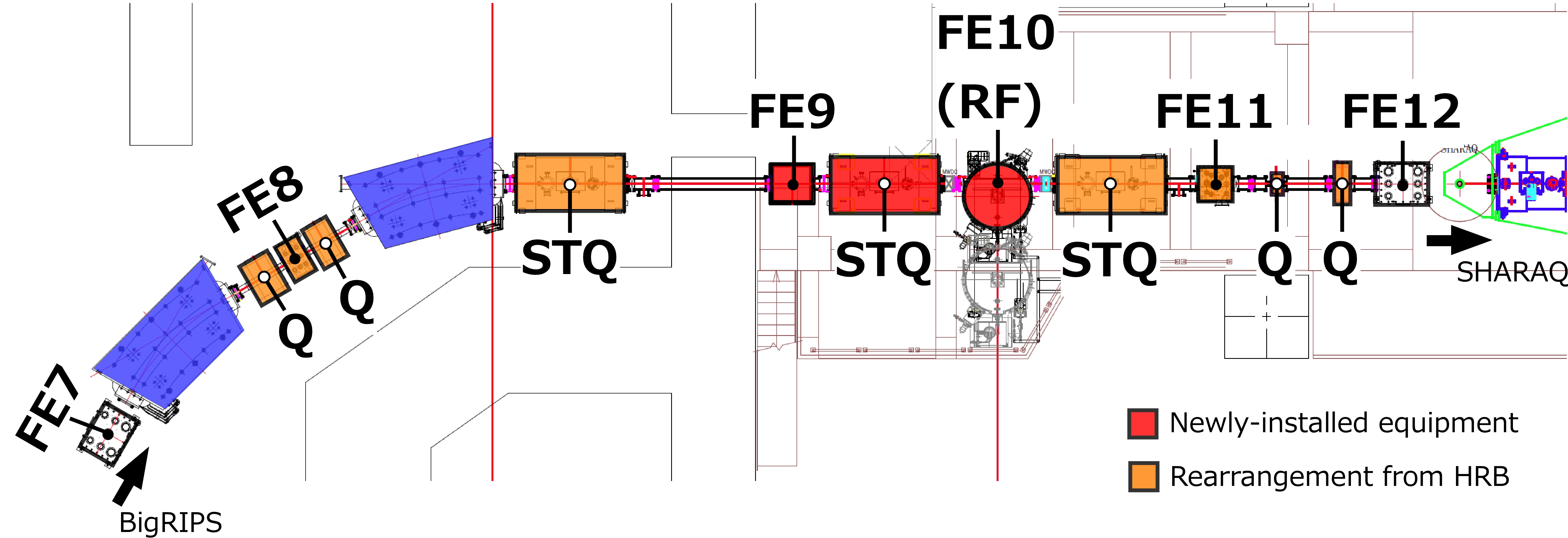Technical Information のバックアップ(No.17)
- バックアップ一覧
- 差分 を表示
- 現在との差分 を表示
- 現在との差分 - Visual を表示
- ソース を表示
- Technical Information へ行く。
- 1 (2015-07-28 (火) 17:48:27)
- 2 (2015-07-28 (火) 18:02:24)
- 3 (2015-07-29 (水) 15:43:06)
- 4 (2015-07-30 (木) 01:40:20)
- 5 (2015-07-30 (木) 02:01:31)
- 6 (2015-07-30 (木) 11:21:35)
- 7 (2015-07-30 (木) 14:45:11)
- 8 (2015-07-30 (木) 15:54:21)
- 9 (2015-07-31 (金) 11:30:03)
- 10 (2015-08-06 (木) 20:11:24)
- 11 (2015-09-02 (水) 18:20:45)
- 12 (2015-09-02 (水) 18:24:44)
- 13 (2015-09-17 (木) 11:01:22)
- 14 (2017-07-28 (金) 13:17:44)
- 15 (2017-07-28 (金) 17:51:57)
- 16 (2017-07-28 (金) 19:18:54)
- 17 (2017-07-28 (金) 20:16:15)
Beam-line configuration
OEDO project modifies the current beamline which has been operated as "High-Resolution Beam-line" in RIBF, or "SHARAQ" beam line. In March, 2017, new devices of a STQ (Superconducting Triplet Quadrupole magnet) and an RF-deflector have been installed. The most of parts of OEDO beamline were rearranged with existing beamline devices. The commissioning of the OEDO beamline was successfully performed in June, 2017.
The OEDO beamline shares the elements with BigRIPS from F0 to F6. The elements of OEDO after F6 are listed below and the OEDO beamline finally gets connected to the SHARAQ spectrometer.
| F0 - F6 | BigRIPS |
| QQQ - QQQ | |
| FE7 | Vacuum chamber for beam monitor |
| D - Q | |
| FE8 | Dispersive focus |
| Q - D - QQQ | |
| FE9 | Dispersive focus for an energy degrader |
| QQQ | |
| FE10 | RF deflector |
| QQQ | |
| FE11 | Achromatic focus |
| QQQ | |
| FH12/S0 | Achromatic focus |
| SHARAQ spectrometer | |
| S2 | Focus for measurements of outgoing particles |
From the preliminary result of the commissioning experiment, the following parameters must be taken into account to estimate the beam intensity at the OEDO beamline.
- the momentum at F1 was set to be ± 1%,
- the spot size at BigRIPS F3 was 10 mm in diameter.
Then, the transmission of the secondary beam to the secondary target position (S0) was preliminarily estimated to be 10%.:
Intensity estimation for your proposals
Though the energy degraded RI beam production scheme by OEDO is still under development, the beam intensity at the secondary target can be estimated by using the following conditions:
- Momentum acceptance : ± 1%,
- Spot size at F3 : smaller than 10mm diameter,
- Angular acceptance at F3 : smaller than 10mrad(H) and 20mrad(V),
With the conditions above, transmission to the secondary target can be estimated to be 10%, which is based on the preliminary result of the commissioning.
You are able to estimate the secondary beam intensity at F3 which satisfies the above conditions #1-3 by using a simulation code such as LISE++. 10% of the value is a rough indication of beam intensity at S0.
Because parameters to degrade the beam energy strongly depend on each isotope and the desired beam energy, we cannot fully assure the intensity at S0. If you are interested in the development of OEDO-SHARAQ beam line and wish to make experiments, we always welcome research collaborations with you.
This web page will be updated accompanying with development of OEDO. Before preparing the experimental proposals, we would like you to contact the scientific coordinator of OEDO, Prof. N.Imai (n.imai_at_cns.s.u-tokyo.ac.jp).
 ホーム
ホーム 一覧
一覧 単語検索
単語検索 最終更新
最終更新 ヘルプ
ヘルプ